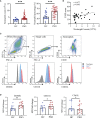Enhanced Migratory Ability of Neutrophils Toward Epidermis Contributes to the Development of Psoriasis via Crosstalk With Keratinocytes by Releasing IL-17A
- PMID: 35401573
- PMCID: PMC8983831
- DOI: 10.3389/fimmu.2022.817040
Enhanced Migratory Ability of Neutrophils Toward Epidermis Contributes to the Development of Psoriasis via Crosstalk With Keratinocytes by Releasing IL-17A
Abstract
Microabscess of neutrophils in epidermis is one of the histological hallmarks of psoriasis. The axis of neutrophil-keratinocyte has been thought to play a critical role in the pathogenesis of psoriasis. However, the features and mechanism of interaction between the two cell types remain largely unknown. Herein, we found that blood neutrophils were increased in psoriasis patients, positively correlated with disease severity and highly expressed CD66b, but not CD11b and CD62L compared to healthy controls. Keratinocytes expressed high levels of psoriasis-related inflammatory mediators by direct and indirect interaction with neutrophils isolated from psoriasis patients and healthy controls. The capacity of neutrophils in provoking keratinocytes inflammatory response was comparable between the two groups and is dependent on IL-17A produced by itself. Neutrophils isolated from psoriasis patients displayed more transcriptome changes related to integrin and increased migration capacity toward keratinocytes with high CD11b expression on cell surface. Of interest, neutrophils were more susceptible to keratinocyte stimulation than to fibroblasts and human umbilical vein endothelial cells (HUVECs) in terms of CD11b expression and the production of ROS and NETs. In conclusion, neutrophils from psoriasis patients gain a strong capacity of IL-17A production and integrins expression that possibly facilitates their abilities to promote production of psoriasis-related inflammatory mediators and migration, a phenomenon likely induced by their interaction with keratinocytes but not with fibroblasts. These findings provide a proof-of-concept that development of new drugs targeting migration of neutrophils could be a more specific and safe solution to treat psoriasis.
Keywords: interleukin-17A; keratinocytes; migration; neutrophils; psoriasis.
Copyright © 2022 Liu, Shi, Lu, Hong, Qiu, Tan, Xiong, Guo and Wang.
Conflict of interest statement
The authors declare that the research was conducted in the absence of any commercial or financial relationships that could be construed as a potential conflict of interest.
Figures





Similar articles
-
Interleukin-17A and Keratinocytes in Psoriasis.Int J Mol Sci. 2020 Feb 13;21(4):1275. doi: 10.3390/ijms21041275. Int J Mol Sci. 2020. PMID: 32070069 Free PMC article. Review.
-
Development of psoriasis by continuous neutrophil infiltration into the epidermis.Exp Dermatol. 2018 Oct;27(10):1084-1091. doi: 10.1111/exd.13746. Epub 2018 Aug 14. Exp Dermatol. 2018. PMID: 30019426 Review.
-
Interleukin (IL)-17/IL-36 axis participates to the crosstalk between endothelial cells and keratinocytes during inflammatory skin responses.PLoS One. 2020 Apr 30;15(4):e0222969. doi: 10.1371/journal.pone.0222969. eCollection 2020. PLoS One. 2020. PMID: 32352958 Free PMC article.
-
Interleukin-17A Drives IL-19 and IL-24 Expression in Skin Stromal Cells Regulating Keratinocyte Proliferation.Front Immunol. 2021 Sep 20;12:719562. doi: 10.3389/fimmu.2021.719562. eCollection 2021. Front Immunol. 2021. PMID: 34616394 Free PMC article.
-
Evidence that a neutrophil-keratinocyte crosstalk is an early target of IL-17A inhibition in psoriasis.Exp Dermatol. 2015 Jul;24(7):529-35. doi: 10.1111/exd.12710. Epub 2015 May 8. Exp Dermatol. 2015. PMID: 25828362 Free PMC article. Clinical Trial.
Cited by
-
Dual targeting of mTOR/IL-17A and autophagy by fisetin alleviates psoriasis-like skin inflammation.Front Immunol. 2023 Jan 18;13:1075804. doi: 10.3389/fimmu.2022.1075804. eCollection 2022. Front Immunol. 2023. PMID: 36741386 Free PMC article.
-
The Potential Importance of CXCL1 in the Physiological State and in Noncancer Diseases of the Cardiovascular System, Respiratory System and Skin.Int J Mol Sci. 2022 Dec 22;24(1):205. doi: 10.3390/ijms24010205. Int J Mol Sci. 2022. PMID: 36613652 Free PMC article. Review.
-
The Central Roles of Keratinocytes in Coordinating Skin Immunity.J Invest Dermatol. 2024 Nov;144(11):2377-2398. doi: 10.1016/j.jid.2024.06.1280. Epub 2024 Aug 8. J Invest Dermatol. 2024. PMID: 39115524 Review.
-
A comprehensive overview of psoriatic research over the past 20 years: machine learning-based bibliometric analysis.Front Immunol. 2023 Oct 26;14:1272080. doi: 10.3389/fimmu.2023.1272080. eCollection 2023. Front Immunol. 2023. PMID: 37954610 Free PMC article.
-
The Immunology of Psoriasis-Current Concepts in Pathogenesis.Clin Rev Allergy Immunol. 2024 Apr;66(2):164-191. doi: 10.1007/s12016-024-08991-7. Epub 2024 Apr 20. Clin Rev Allergy Immunol. 2024. PMID: 38642273 Free PMC article. Review.
References
-
- Sumida H, Yanagida K, Kita Y, Abe J, Matsushima K, Nakamura M, et al. . Interplay Between CXCR2 and BLT1 Facilitates Neutrophil Infiltration and Resultant Keratinocyte Activation in a Murine Model of Imiquimod-Induced Psoriasis. J Immunol (2014) 192(9):4361–9. doi: 10.4049/jimmunol.1302959 - DOI - PubMed
MeSH terms
Substances
LinkOut - more resources
Full Text Sources
Medical
Research Materials

